Chicken Breeds: Plymouth Rock and Barred Rock Chickens
Plymouth Rock chickens
have
been a popular breed for years, including in the USA, especially the
Barred Rock chickens. However, there are several more
types of this particular chicken breed which have resulted in different
feather color
and markings.
However, no matter what color they are the chickens from this chicken breed all have good natures, are really friendly if you have them from chicks - I wasn't so lucky - are relatively calm birds if raised properly and had a fair amount of contact and interaction with people.
As a result they make excellent pets for children, despite their size and are one of the best chicken breeds for being dual-purpose.
1) Barred Plymouth Rocks
2) White Plymouth Rocks
3) Buff Plymouth Rocks
4) Columbian Plymouth Rock
5) The Silver-Penciled Plymouth Rocks
6) The Partridge Plymouth Rock
Barred Plymouth Rock chickens were the original variety and are said to have been developed using the bloodlines of the Braham, Black Java, the Black Cochin, the Dominique and the Pit Game fowl.
These are large birds, with the roosters weighing in on average at 9 1/2 pounds and the hens at 7 1/2 pounds. This makes them a great dual-purpose bird as when they have stopped laying, or being productive as breeding stock, then they are a good size for the pot.
The Barred Plymouth Rock is by far the most popular farm fowl. The bird will have grayish-white feathers, each feather, which is narrow at the end, has bars or lines of dark charcoal to almost black on them. Ideally, the bars should be evenly spaced and the tips should be solid.
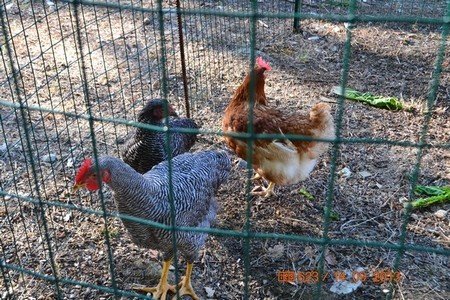
Our Barred Plymouth Rooster and Hen as Youngsters.
We have several Plymouth Rocks, our first pair were 2 Barred Plymouth Rocks, one rooster and the other a hen. The hen lays huge eggs with a pinkish shell, and the rooster is a large, handsome bird who struts his stuff around the farmhouse with the rest of the flock. I have found her to be an excellent laying hen, especially in winter when the rest of the flock may be a bit sluggish, she continues to lay most days. This chicken breed has yellow legs, a single red comb.
Unfortunately, our Plymouth Rock hen was at point of lay when we got her, so she is rather skittish and won't allow me to touch her, and neither will the rooster. However, despite this, they will come running when they see people looking for scraps of food and the rooster is most comical in the way he waddles as he runs, because of his large size. He is a really handsome fellow, and at the moment just beginning to develop some rather fetching iridescent side feathers. Some purists would say that this is a fault in the breed, however, as we don't show them, we are happy to have him about, showing off his pretty plumage.
The White Plymouth Rock is much larger in size than the barred variety and is snow white with no colored barring at all. A very pretty bird with yellow legs and beak and a red single comb.
The Buff Plymouth Rock is a pretty bird, and like the white variety, the feather should have no barring or lines at all, just an even light caramel color throughout.
The Columbian Plymouth Rock is a fairly new variety that has striking plumage. The feathers are mostly white, with the feathers on the neck black with a narrow band of white. The tail feathers are mainly black with some white lacing on the upper feathers. They look very similar to the Light Sussex in markings.
In fact, when we got our 5 girls at point of lay we were sold the birds as Light Sussex. However, on closer inspection they were in fact Columbian Plymouth Rocks. Both lay light brown eggs, so difficult to tell the difference until you look at the leg color. The Light Sussex have a pinkish color to their legs, while the Columbian Plymouth Rocks have yellow legs. There are some other slight differences, but this was the easiest to spot straight away. They are excellent layers, again, no problems here for winter laying, and very consistent.
Another fairly new variety of Rock, the Silver-Penciled Plymouth Rock has very pretty feathers. Here the birds have a silver-white color to their feathers and the pattern is very similar to that of a Dark Brahma or a Wyandotte.
Again, a fairly new variety by comparison, and their markings are very similar to that of the Patridge Cochin, as well as the Silver-Penciled Plymouth Rock, except that where there are white feathers, these feathers are a reddish brown instead.
However, no matter what color they are the chickens from this chicken breed all have good natures, are really friendly if you have them from chicks - I wasn't so lucky - are relatively calm birds if raised properly and had a fair amount of contact and interaction with people.
As a result they make excellent pets for children, despite their size and are one of the best chicken breeds for being dual-purpose.
Different Types of Plymouth Rocks
1) Barred Plymouth Rocks
2) White Plymouth Rocks
3) Buff Plymouth Rocks
4) Columbian Plymouth Rock
5) The Silver-Penciled Plymouth Rocks
6) The Partridge Plymouth Rock
1) Barred Plymouth Rock Chickens
Barred Plymouth Rock chickens were the original variety and are said to have been developed using the bloodlines of the Braham, Black Java, the Black Cochin, the Dominique and the Pit Game fowl.
These are large birds, with the roosters weighing in on average at 9 1/2 pounds and the hens at 7 1/2 pounds. This makes them a great dual-purpose bird as when they have stopped laying, or being productive as breeding stock, then they are a good size for the pot.
The Barred Plymouth Rock is by far the most popular farm fowl. The bird will have grayish-white feathers, each feather, which is narrow at the end, has bars or lines of dark charcoal to almost black on them. Ideally, the bars should be evenly spaced and the tips should be solid.

Our Barred Plymouth Rooster and Hen as Youngsters.
We have several Plymouth Rocks, our first pair were 2 Barred Plymouth Rocks, one rooster and the other a hen. The hen lays huge eggs with a pinkish shell, and the rooster is a large, handsome bird who struts his stuff around the farmhouse with the rest of the flock. I have found her to be an excellent laying hen, especially in winter when the rest of the flock may be a bit sluggish, she continues to lay most days. This chicken breed has yellow legs, a single red comb.
Unfortunately, our Plymouth Rock hen was at point of lay when we got her, so she is rather skittish and won't allow me to touch her, and neither will the rooster. However, despite this, they will come running when they see people looking for scraps of food and the rooster is most comical in the way he waddles as he runs, because of his large size. He is a really handsome fellow, and at the moment just beginning to develop some rather fetching iridescent side feathers. Some purists would say that this is a fault in the breed, however, as we don't show them, we are happy to have him about, showing off his pretty plumage.
2) The White Plymouth Rock
The White Plymouth Rock is much larger in size than the barred variety and is snow white with no colored barring at all. A very pretty bird with yellow legs and beak and a red single comb.
3) The Buff Plymouth Rock
The Buff Plymouth Rock is a pretty bird, and like the white variety, the feather should have no barring or lines at all, just an even light caramel color throughout.
4) Columbian Plymouth Rock
The Columbian Plymouth Rock is a fairly new variety that has striking plumage. The feathers are mostly white, with the feathers on the neck black with a narrow band of white. The tail feathers are mainly black with some white lacing on the upper feathers. They look very similar to the Light Sussex in markings.
In fact, when we got our 5 girls at point of lay we were sold the birds as Light Sussex. However, on closer inspection they were in fact Columbian Plymouth Rocks. Both lay light brown eggs, so difficult to tell the difference until you look at the leg color. The Light Sussex have a pinkish color to their legs, while the Columbian Plymouth Rocks have yellow legs. There are some other slight differences, but this was the easiest to spot straight away. They are excellent layers, again, no problems here for winter laying, and very consistent.
5) Silver-Penciled Plymouth Rock
Another fairly new variety of Rock, the Silver-Penciled Plymouth Rock has very pretty feathers. Here the birds have a silver-white color to their feathers and the pattern is very similar to that of a Dark Brahma or a Wyandotte.
6) Partridge Plymouth Rock
Again, a fairly new variety by comparison, and their markings are very similar to that of the Patridge Cochin, as well as the Silver-Penciled Plymouth Rock, except that where there are white feathers, these feathers are a reddish brown instead.



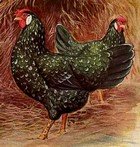
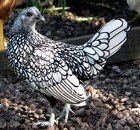

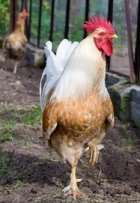
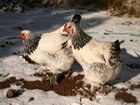
New! Comments
Do you have something of value to add? Leave me a comment in the box below.